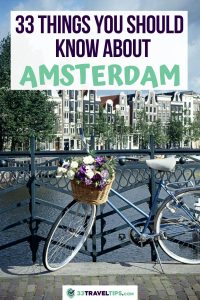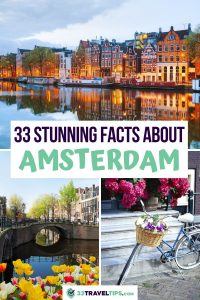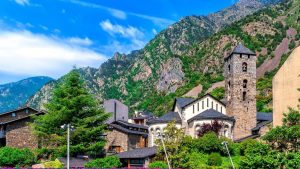
Amsterdam is famous for its coffeeshops, crooked houses, and notorious red-light districts.
But did you know that it also has more canals and bridges than Venice and Paris combined? Or that in this cosmopolitan city, there are more bicycles than residents?
In this post, you’ll find 33 stunning facts about Amsterdam, which will make you want to explore the quirky Dutch capital immediately.
Dive right in to find out what makes Amsterdam unique!
✅ Note: This article contains affiliate links. In case you purchase something through one of these links, we may receive a small commission at no extra cost to you. Thank you for helping us keep creating the free content on this website!
Understanding Amsterdam – The People and the Symbols of the Dutch Capital
Ever wondered why orange is the color most associated with the Netherlands? Or what the peculiar symbol of Amsterdam means?
Find the answers in these fun facts about Amsterdam:
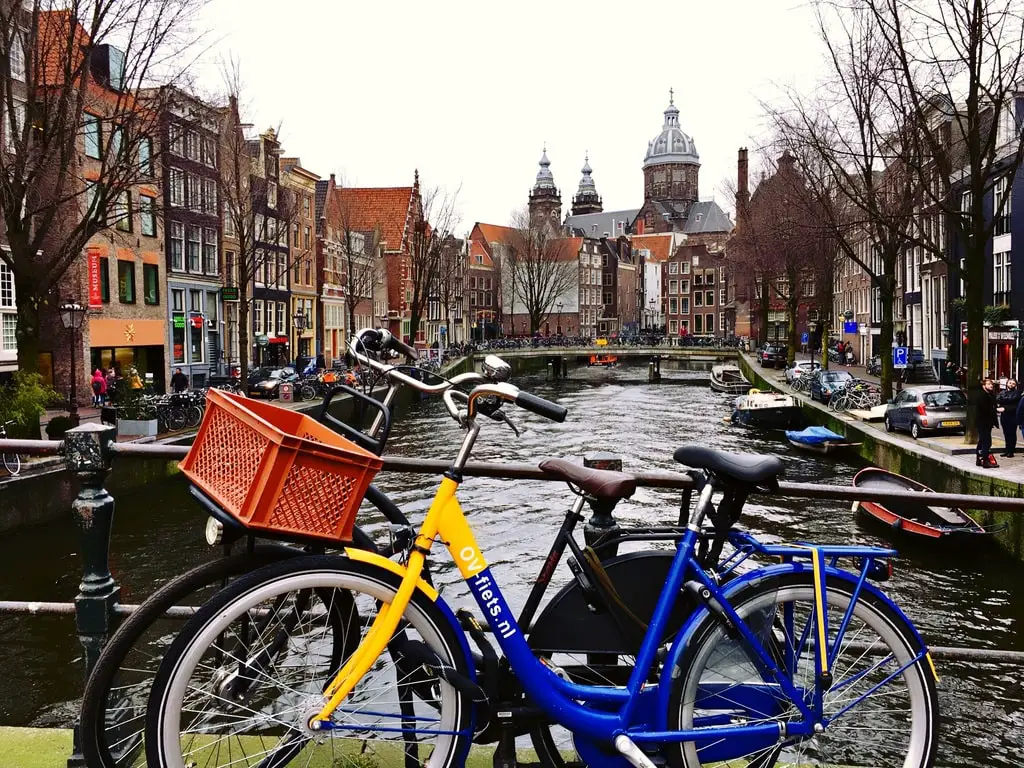
- Amsterdam is very cosmopolitan. While its urban population is less than 1 million, it consists of 180 nationalities. But that’s not all. Nearly 20 million people from all over the world visit it each year. You can join them, too. Plan your trip with the help of our Amsterdam travel tips.
- The Dutch love their bicycles. We’re certain they learn to bike before they learn to walk. Amsterdam’s urban population is about 800,000, while the number of bikes is close to 900,000. Cyclists are everywhere: in the narrow cobblestoned alleys, between the tram tracks, on the bridges, and even in the boats. So be extra careful when walking in Amsterdam – there’s always the possibility of a cyclist running you over. Around 15,000 bicycles end in the canals each year. The city recovers about one third.
- Prepare to see lots of tall people in Amsterdam. On average, the tallest people in the world live in the Netherlands. The average height of Dutchmen is 6 ft. / 182.53 cm, while Dutch women are 5 ft. 6 in / 168.72 cm tall.

- The symbol of Amsterdam – the three Xs – does not stand for what you might think. It is not as many people assume an abbreviation for the Red-Light District or adult entertainment. In fact, it represents three vertical St. Andrew’s Crosses. The saint was a fisherman, tortured on a cross in the 1st century. The symbol is used since the 16th century when Amsterdam was a fishing town.
- Orange is the color most associated with the Netherlands, despite the colors of the official Dutch flag being red, white, and blue. This comes from the Royal Family, which originates from the House of Orange. If you happen to be in Amsterdam on April 27, King’s Day, you’ll be in for an unbelievable sight. The whole city is flooded with people wearing orange!

- The port of Amsterdam is the 3rd largest cruise port and the 4th busiest cargo seaport in Europe. It has been in use since the 13th century. In the 1700s, it was one of the main harbors used by the Dutch East India Company. It connects to the North Sea through the North Sea Canal, and to the River Rhine via the Amsterdam-Rhine Canal. Close to 700,000 cruise passengers visit each year, arriving on approximately 140 sea cruise ships and 1,500 river cruise ships.
- Only one windmill in Amsterdam is still open to the public. The city center used to be packed with mills serving different purposes. Some helped prevent flooding, while others ground mustard, the favorite condiment of the Dutch. When the city center grew, many were relocated or dismantled, and only eight remained. The only one you can visit nowadays is Molen van Sloten. It has been functioning since 1847. Today, the mill offers tours and demonstrations.
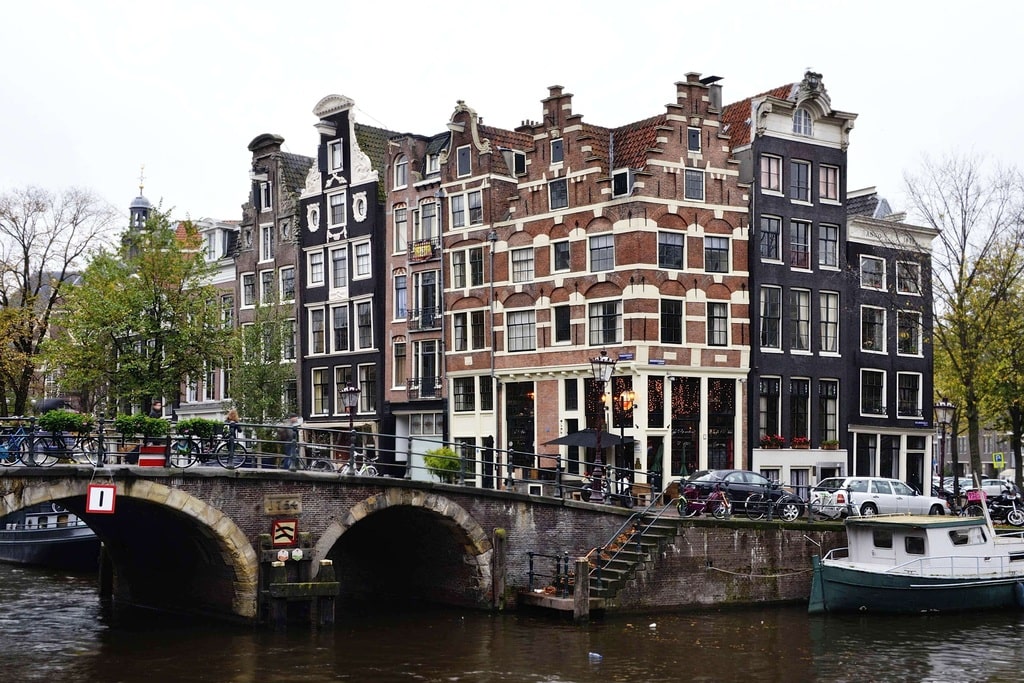
- Most houses in the historical center are crooked. The main reason is the wooden poles, which hold the constructions. They’re drilled into the wet soil and constantly exposed to water. Over the years – some were erected in the 17th century – the poles sunk or twisted unevenly. This gave the houses of Amsterdam their typical crooked look. Another peculiarity of the buildings is their tilted façades. The houses lean towards the street or canal in order to pull up goods and get them inside through the windows. Going up the stairs isn’t an option because most houses don’t have wide enough doors or staircases.
Adult Entertainment in Amsterdam – Red-Light Districts, Prostitution, and Cannabis
With these facts about Amsterdam’s adult entertainment, we want to provide an insight into the quirkiest lifestyle in Europe.
For example, smoking hash or cannabis is more tolerated than smoking tobacco. To find out what is legal and safe to do in the red-light districts and coffeeshops of Amsterdam, read on:

- Amsterdam is an international sex tourism destination. In the Netherlands, prostitution is legal and regulated. So is owning a bordello. 90% of the sex workers are female, about 5% are male, and approximately 5% are transgender. Around one third are Dutch citizens. The rest come from other 44 nationalities.
- Amsterdam hosts three red-light areas – De Wallen, Ruysdaelkade, and Singelgebied. The most popular and provocative one is De Wallen, which is also the largest and the oldest. Even if you only spend one day in Amsterdam, include a red-light district in your itinerary. Strolling its streets is quite a unique experience.
- De Wallen is infamous for its window brothels. The neighborhood consists of a chain of alleys, housing close to 300 one-room cabins. Ladies of the night rent these tiny spaces to offer their sexual services. You’ll find them sitting or dancing behind a window that has red lights on – hence the name. Have in mind that a blue or purple light means that a transgender sex worker occupies the window brothel. In the district, you’ll also find sex shops, peep shows, sex theaters, numerous coffeeshops, as well as a sex and a cannabis museum. It’s probably the best area to explore if you’re looking for the most unusual things to do in Amsterdam.
- If you decide to indulge in adult entertainment, go to an official place. Picking up a working girl from the streets is illegal – both parties will get a fine. Taking an escort to your hotel room is allowed, though. The window brothels have a starting price of $55 for 15 minutes. The sex workers always use a condom.
- Drinking in public in the red-light district is forbidden. So is smoking cannabis on the streets of Amsterdam. You can also get into trouble by trying to photograph the ladies of the night.

- People rarely visit the 160+ coffeeshops in Amsterdam for the coffee. Sure, the establishments serve coffee as well, but they mainly sell different marijuana strains. You can pick your taste from a large menu, just like in any coffee shop around the world you would order your cup of Joe. If you’re uncertain what kind of establishment you’re walking in, let your nose lead the way. We bet it can distinguish between the smell of freshly brewed coffee and freshly lit joint.
- Coffeeshops are not allowed to advertise, but you can identify them easily. And we don’t just mean by the specific aromas. Licensed sellers have an official green and white sticker. To enter a coffeeshop, you must be at least 18 years old and carry an ID. Prices start at $5 per gram and get higher the closer you are to the city center. You’re allowed to possess up to 5 grams.
- Using hard drugs, e.g. cocaine, heroin, morphine, or LSD, is strictly forbidden in all Amsterdam coffeeshops. Also banned are hallucinogenic mushrooms and qat. The unique traffic sign Blowverbod prohibits blowing, so if you see it, it means no smoking of hash or other drugs is allowed.
Food and Drinks – What to Taste in Amsterdam
The Dutch capital might not be the best gastronomic destination in the world, but we bet you’ll start drooling after learning the following culinary facts about Amsterdam:
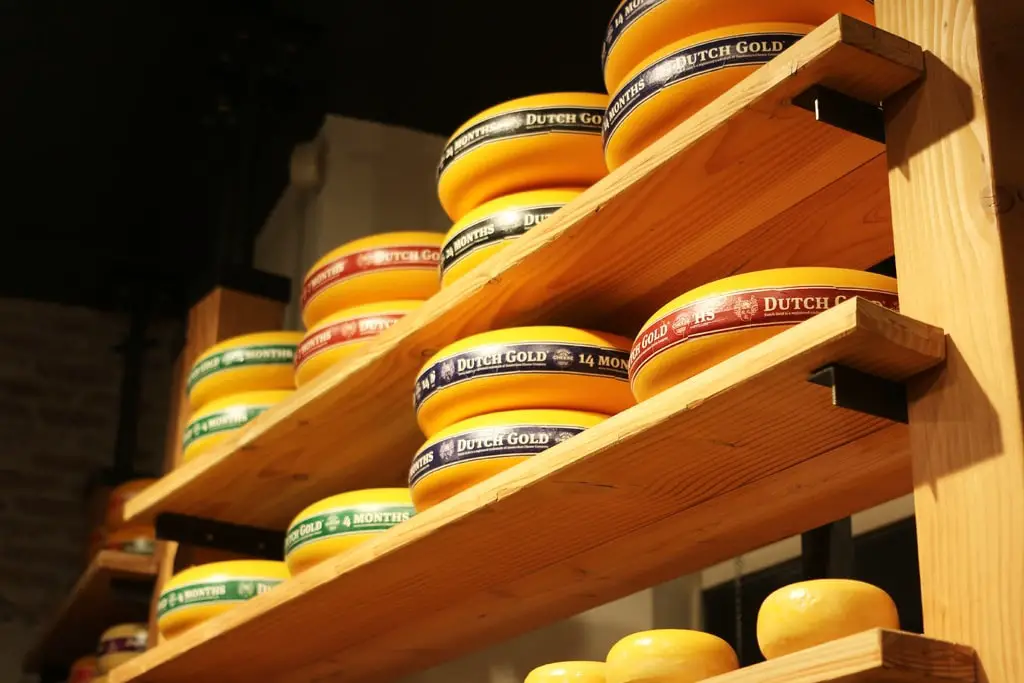
- If you’re looking for your caffeine fix, you need a koffiehuis. The Dutch are the world’s largest coffee consumers per capita. You’ll be in for a real coffee treat, especially if you couple your caffeine drink with the typical Dutch apple pie. By the way, if you’re not confused enough by the distinction between coffeeshops and coffee houses already, cafés in Amsterdam are more like bars and restaurants than anywhere else in the world.
- The Netherlands is the #1 cheese-exporting nation. What’s your favorite cheese? Edam? Gouda? Leyden, Maasdam, or Limburger? Yes, they’re all Dutch! The country’s cheese-making traditions trace back to 400 AD. The Dutch capital is the country’s cheese trading center. In short – when in Amsterdam, try the cheeses. You’ll be in for a scrumptious treat! Also, there’s a Cheese Museum at the Prinsengracht 112.
- Amsterdam has been a major beer brewing center since the 1500s. At that time, water was unsafe to drink. Nowadays, Heineken – founded in Amsterdam – is among the top 3 largest beer breweries in the world.
Venice of the North – A Journey through Canals and Bridges
We bet when you think of canals and boat rides, you picture the Italian city of Venice.
After reading these facts about Amsterdam, we’re certain you’ll have a different image in your mind 😉
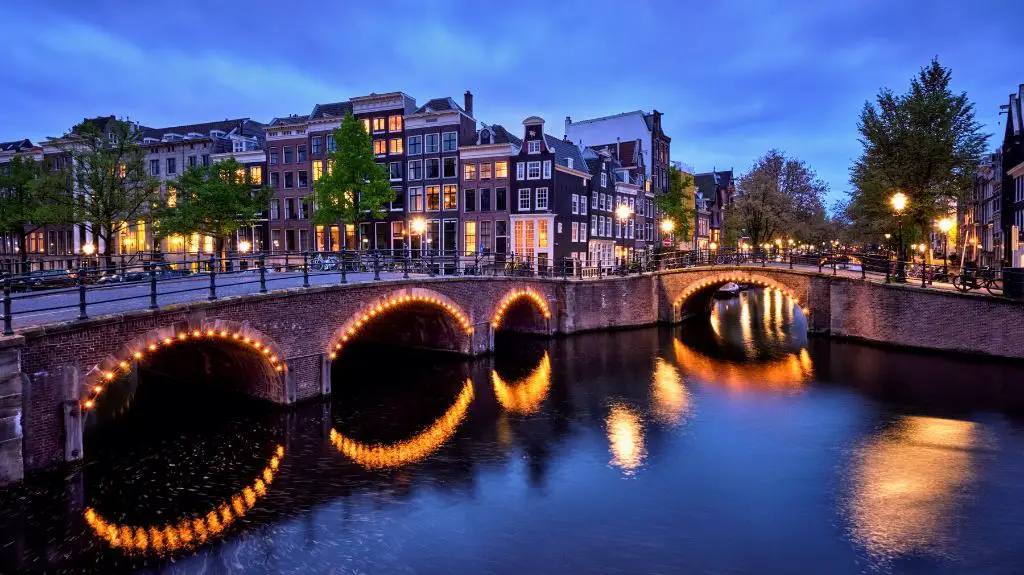
- Amsterdam is below sea level. Just like most of the Netherlands, the capital city has an average elevation of -6.5 ft. / -2 m. At its lowest point, its altitude is almost 23 ft. / 7 m below sea level. Even Schiphol Airport is at -11 ft. / -3 m.
- 165 canals with a total length of 60 mi / 75 km crisscross the city and connect its islands by 1,753 bridges. To put this in perspective, Venice has 150 canals and 391 bridges, while 37 bridges span the River Seine in Paris. No wonder then that since 2010, Amsterdam’s canals are a UNESCO World Heritage Site.
- Around 90 islands form the territory of the Dutch capital. Many of them are man-made. In fact, a whole artificial archipelago, consisting of 10 islands, was built in the last five years to provide additional housing for the ever-growing population of Amsterdam.
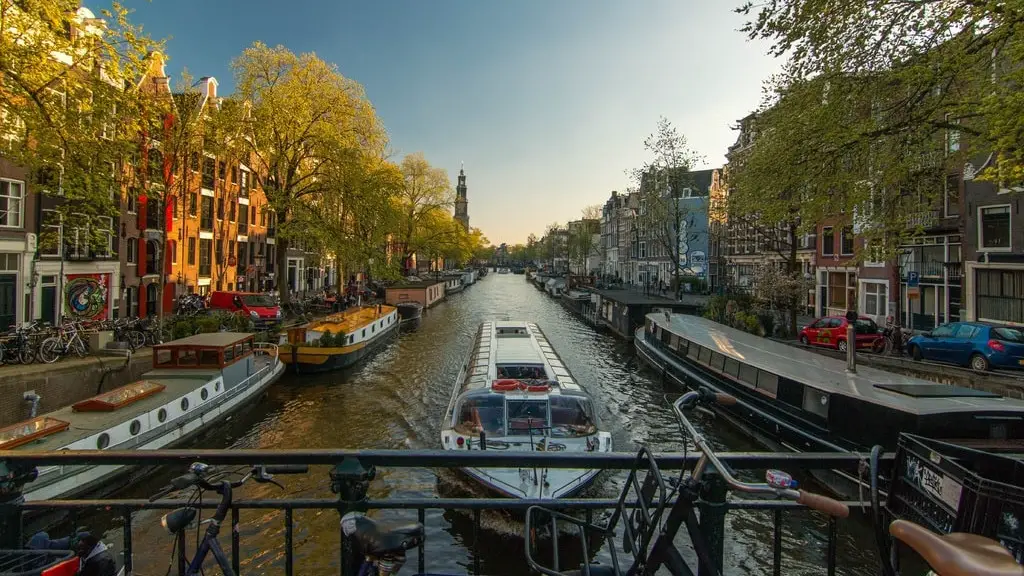
- Approximately 5,500 people live onboard 2,500 houseboats in the canals of Amsterdam. Originally, it was considered a sign of poverty to live on a boat. After WWII, houseboats became a solution to the housing shortage. Nowadays, they are some of the most sought-after accommodations in the city. Many of the unique residences are over 100 years old. They are permanently anchored to a specific address, for which the owner has a special permit. To get a glimpse into the life on a houseboat, visit the Houseboat Museum in the Prinsengracht. You can step inside a 1914 boat, where a Dutch family lived for over 20 years.
- The oldest canal was built in 1385, and the oldest bridge, still in its original state, was erected in 1648. Oudezijds Voorburgwal Canal flows through De Wallen, dissecting the red-light district in two. The Torensluis Bridge was constructed as a part of Amsterdam’s moat. It is also the widest bridge in the city.
- The Bridge of Bridges is a truly unique spot in Amsterdam. It’s the only place in the city where you can marvel at so many bridges all at once. The best vantage point is from the water, onboard one of the canal cruises. When you reach the intersection of Herengracht and Reguliersgracht, look in every direction. There are seven visible bridges on the Herengracht and seven down the Reguliersgracht.
The Sights of Amsterdam – The Peculiar Attractions and Unique Spots
Did you know that Amsterdam has more museums per capita than any other place in the world?
The following facts about the Dutch capital are all about the most interesting and fun attractions in the city.

- Amsterdam’s Royal Palace is the biggest and most prestigious building from the so-called Dutch Golden Age. That’s a period of time in the 17th century when Amsterdam became Europe’s most important city. The capital owed its riches to trading on the high seas. In the past, the Royal Palace served as a city hall for magistrates. Nowadays, the King and his entourage use it for royal events. The palace is public during the year but is closed for visits on days when royal proceedings take place.
- The Rijksmuseum holds more than 8,000 art and historical objects on display. Inside, you’ll find the masterworks of Rembrandt, Frans Hals, and Johannes Vermeer. Yearly, 2+ million people explore it, making it the Netherlands’ most visited museum.
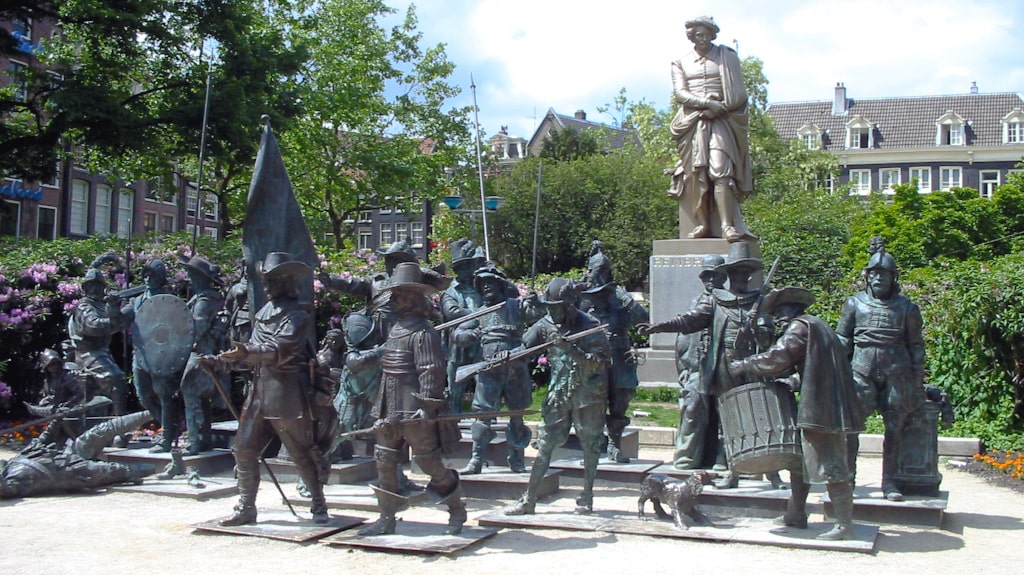
- You can see a 3-D bronze version of Rembrandt’s famous The Night Watch at Rembrandtplein. The scene depicts the nearly life-sized figures of The Shooting Company of Frans Banning Cocq and Willem van Ruytenburch (the painting’s official name). The original masterpiece is, of course, in the Rijksmuseum.
- Europe’s highest swing is at A’DAM Lookout. Tilt over the edge of the 328-feet-/100-meter-high swing to admire a jaw-dropping vista of Amsterdam or scream your lungs out. The tower’s 22 floors make it the tallest building in the city.
- You can visit the brewery where one of the world’s most famous beers originated. The Heineken Experience will entertain you with four levels of historical artifacts, product discovery and sampling, as well as interactive exhibits.
- The Amsterdam Flower Market (Bloemenmarkt) is the only floating flower market in the world. The unique marketplace has existed for over 150 years. The flower stalls stand directly on houseboats, just like in the old days. You can explore the most fragrant and vibrant place in the Dutch capital Monday through Saturday. Find it on the Singel Canal between Koningsplein and Muntplein.
- Albert Cuypmarkt is the largest outdoor market in Europe. On its impressive 260 stands, positioned on approximately 2,000 ft. / 600 m, you’ll find anything from exotic fruits, flowers, and fish to books, leather goods, and clothing. The vendors are famous for their typical Amsterdam humor, and they’ll probably throw a joke or two at you. The Albert Cuyp Market has been functioning since 1905 and is open from Monday to Saturday.
- The smallest house in Europe is located in Amsterdam. The exact address is Oude Hoogstraat 22. It measures only 6 ft. 8 in / 2.02 m in width and 16 ft. 5 in / 5 m in depth, and has just one room per floor. The typical canal house was built around 1738. Currently, it accommodates the smallest tea room in Amsterdam. If you’re a tea lover, definitely add it to your itinerary.
Which Fun Facts about Amsterdam Surprised You the Most?
There you have it – the most interesting facts about Amsterdam.
Now, do us a favor: tell us which fact surprised you the most? Or did you already know everything we shared about the quirky Dutch capital?
